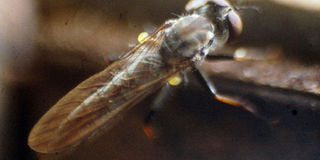Tsetse fly control council seeks Sh1.2bn, says 11m Kenyans at risk

A tsetse fly craws on a piece of wood in Mt Kenya Forest on June 17, 2009. The agency tasked with containing the tsetse flies and sleeping sickness has asked for Sh1.2 billion. PHOTO| FILE
What you need to know:
Kenya Tsetse and Trypanosomiasis Eradication Council (KENTTEC) has also called for passing of Tsetse and Trypanosiamiasis Eradication Bill.
The government agency tasked with eradication of tsetse flies and sleeping sickness, trypanosomiasis, has asked for Sh1.2 billion budget, saying 11 million Kenyans at risk in 38 counties.
Kenya Tsetse and Trypanosomiasis Eradication Council (KENTTEC) has also called for passing of Tsetse and Trypanosiamiasis Eradication Bill.
Recently, Health Cabinet Secretary Sicily Kariuki said government targets to eradicate neglected tropical diseases, such as sleeping sickness, by 2020.
The blood-sucking tsetse flies transmit sleeping sickness (African trypanosomiasis) in humans and a similar disease called nagana in domestic animals.
World Health Organisation website shows that sleeping sickness occurs in 36 sub-Saharan countries.
FOOD SECURITY
KENTTEC chief executive, Dr Pamela Olet, said the 38 infested counties will not achieve food security and nutrition goals if the tsetse fly and trypanosomiasis problem is not addressed.
"Meru Conservation Area requires a minimum of Sh300,000,000 for aerial spraying, ecological monitoring, barrier installation and sensitisation, Sh600 million to sustain gains in Lambwe, Busia, Bungoma, Meru/Embu, Bogoria and Coast and Sh300 million to upscale control programmes to other infested areas of the country," Ms Olet said.
KENTTEC said it also needs the funds to recruit 431 more staff to operationalise the council.
Ms Olet was speaking when she presented the council’s findings to the Agriculture Cabinet Cabinet Secretary Mwangi Kiunjuri during his meeting with 29 heads of parastatals in Mombasa.
"We should reduce livestock mortality, improve breeds, increase productivity of milk, meat and crop. Availability of milk will contribute to the school milk programme. T and T control supports the feed lot programme in the Agriculture Sector Programme," said Ms Olet.
The agency wants aerial spraying, monitoring, barrier installation and sensitisation programmes extended to Mara-Serengeti ecosystem in the South Rift, Turkana-West Pokot-Elgeyo Marakwet, Laikipia, North Rift, Coastal tsetse belt, Nothern Kenya tsetse belt, Isiolo-Laikipia-Samburu and Meru Conservation Area for aerial spraying, ecological monitoring, barrier installation and sensitisation.
POVERTY INSECT
The agency was established by the government in July 2012 to succeed the Pan-Afrian Tsetseand Trypanosomiasis Eradication Campaign (PATTEC) in Kenya.
PATTEC was formed after African heads of states and government made a declaration in Lome, Togo in July 2000 to free the African continent from the devastating effects of tsetse fly which they termed a poverty insect.





